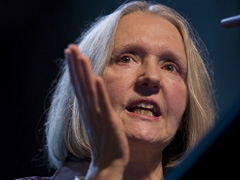The Dutch-American sociologist speaks about the social expulsions of the system and says that the street should be taken over by pedestrians: deritualising the public space of mega-cities in the face of their increasing overdetermination.
Shared Spaces recorded this conversation with Saskia Sassen in February 2015 when she visited the Centre of Contemporary Culture of Barcelona (CCCB) to give the lecture “Justice and Equality” in the Barcelona Debate 2015 – Wield the Word series. One of the themes she discussed in her lecture was the term – social – expulsion, which she distinguishes from the term – social – exclusion. The difference lies in the fact that the former occurs from within the system, from which one is expelled and excluded from entering again, while the latter does not permit entry.
Expulsion occurs when “a familiar situation takes on an extreme form and moves beyond the bounds of the system, thus becoming invisible because our categories of analysis, of interpretation… do not allow us to see it.” These circumstances might involve, for example, parts of the biosphere, systems of survival, and groups or social categories such as poor, ill or homeless people. She says that, in order for these conditions to take on this extreme form of invisibility, there is a process leading to these events or, in other words, they do not occur by themselves but are caused by human beings.
As one possible remedy for this situation, Sassen upholds the indetermination of the street, which is to say the de-ritualisation of places with ingrained codes of what is done: “public space is a place in which there is a momentary condition of equality”. Although she believes that equality per se does not exist she says it appears at moments when our paths cross in public transport, in a square, in a street.
Hence she identifies the public as political and upholds the right of the pedestrian to take control of the street and to create his or her own culture there and thus confronting overdetermination a feature now being adopted by the new public spaces or megacities or, for example by public parks which are locked up. As a result, she believes that at some point in the future many overused cities will have to be reconstructed.
It is therefore not surprising that Sassen chooses as her favourite public space, not a specific physical space but situations in which the indetermination of the street means that the pedestrian can be in control, giving as an example a case in Bombay. “A massive, heavy car comes along, a Cadillac behind the people, and they keep walking ahead with the car behind them, without even turning round. I think the future looks a bit like this”.



